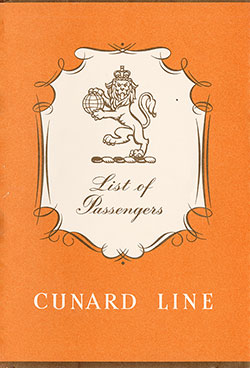1957 Passenger Lists
All Passenger Lists For 1957 Available at the GG Archives. Listing Includes Date Voyage Began, Steamship Line, Vessel, Passenger Class and Route.
Our collection contains samples of passenger lists produced and printed by the steamship lines. These lists are often used to illustrate family history books for immigrants from this period.
Coveted by collectors and genealogists, souvenir passenger lists often offered beautiful graphical covers and information not found in official manifests because they focused on the journey rather than the destination.

1957-08-08 RMS Queen Elizabeth Passenger List
- Steamship Line: Cunard Line
- Class of Passengers: Cabin Class
- Date of Departure: 8 August 1957
- Route: Southampton to New York via Cherbourg
- Commander: Commodore Sir Ivan Thompson
Please help us make our passenger list collection more complete. We would appreciate a digital copy if you have an 1957 souvenir passenger list. Please email us at history@ggarchives.com.
Recap and Summary of 1957 Passenger Lists
Overview
The 1957 passenger lists reflect an era of transition for ocean liner travel, as the airline industry was rapidly advancing, drawing more passengers away from traditional sea voyages. However, transatlantic liners like the RMS Queen Elizabeth continued to serve thousands of passengers, particularly those who sought the luxury and nostalgia of sea travel. Many ships still carried migrants, particularly to North America and Australia, but leisure and business travel were increasingly dominant.
Passenger lists from this year are treasured by genealogists and historians, as they offer insights into migration patterns, tourism trends, and the evolving role of steamship lines in a changing world.
Notable Voyage of 1957
- RMS Queen Elizabeth (August 8, 1957)
- Route: Southampton to New York via Cherbourg
- Commander: Commodore Sir Ivan Thompson
- Significance: As one of Cunard’s flagship ocean liners, the Queen Elizabeth represented the peak of transatlantic luxury. This voyage was part of the liner’s regular crossings between Europe and the United States, a route that was becoming increasingly reliant on first-class and cabin-class passengers as air travel captured much of the tourist market.
Maritime and Travel Trends of 1957
- Decline of Ocean Liners in the Face of Aviation Growth
- The late 1950s saw air travel become more affordable and efficient, with faster flights from New York to London replacing the traditional five-day transatlantic crossings. The Boeing 707 made its first flight in 1957, heralding the arrival of the jet age.
- Though ocean liners still maintained a strong presence, particularly for business executives and elite travelers who preferred the grandeur of ships, airlines were beginning to capture a larger share of transatlantic travel.
- Continued Migration, But Fewer Immigrants by Ship
- While immigration was still a key reason for ocean liner travel, many governments had started limiting large-scale postwar immigration programs. For example, the White Australia Policy was gradually changing, but migration from Britain and Europe was still common, often facilitated by assisted passage schemes.
- North America, particularly Canada, remained a strong destination for European migrants, although more immigrants were now traveling by air.
- The Golden Age of Luxury Liner Travel
- Despite the shift toward aviation, the 1950s remained a glamorous era for transatlantic ocean travel. Ships like the Queen Elizabeth, United States, and Mauretania continued to provide a luxurious experience, with fine dining, grand ballrooms, and entertainment that rivaled the best hotels.
- Cherbourg's Role as a Key Stopover
- Many European passengers from France and beyond continued to board ships at Cherbourg, which remained one of the main embarkation points for transatlantic crossings.
Conclusion
1957 was a defining year in the slow but inevitable decline of passenger ocean liners. While ships like the Queen Elizabeth still provided premier transatlantic service, aviation was taking over as the preferred mode of travel for speed and convenience. However, ocean liners maintained their appeal through luxury and tradition, continuing to transport business travelers, tourists, and some migrants. This year marked the waning years of an era, as ships would soon focus more on cruising rather than transatlantic crossings.
